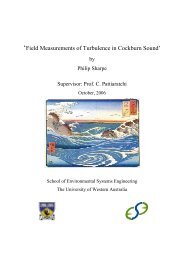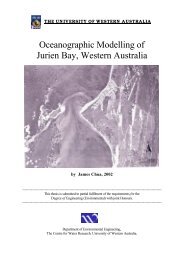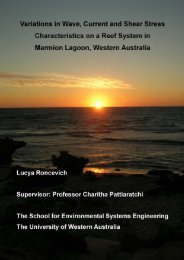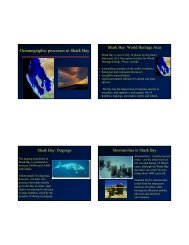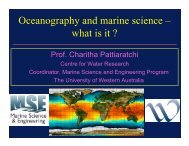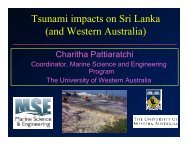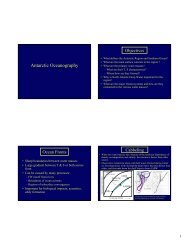Directional Waves in the Nearshore Coastal Region of Perth ...
Directional Waves in the Nearshore Coastal Region of Perth ...
Directional Waves in the Nearshore Coastal Region of Perth ...
Create successful ePaper yourself
Turn your PDF publications into a flip-book with our unique Google optimized e-Paper software.
<strong>Directional</strong> waves <strong>in</strong> <strong>the</strong> nearshore coastal region <strong>of</strong> <strong>Perth</strong>, Western AustraliaHuey Jean Tan• Wave-current and wave-wave <strong>in</strong>teractionsWave transformation analyses for nearshore waves are discussed <strong>in</strong> detail <strong>in</strong> USACE (2002)2.2 THEORIES AND METHODS OF WAVE ANALYSIS2.2.1 Regular <strong>Waves</strong>In nature, ocean surface waves are three-dimensional, irregular and random <strong>in</strong> amplitude,period and direction (Horikawa 1988). The ocean surface typically varies <strong>in</strong> time and isunsteady, and <strong>the</strong>refore <strong>the</strong> ocean surface cannot be adequately described <strong>in</strong> its fullcomplexity. The simplest method to deal with irregular waves is to reduce <strong>the</strong>m to arepresentative two-dimensional monochromatic wave <strong>of</strong> <strong>in</strong>f<strong>in</strong>ite wave crest, to enable <strong>the</strong>application <strong>of</strong> <strong>the</strong> vast knowledge available on periodic waves (Horikawa 1988). Wave<strong>the</strong>ories have been developed only as approximations to real waves based on variousassumptions. The most elementary wave <strong>the</strong>ory is <strong>the</strong> l<strong>in</strong>ear first-order wave <strong>the</strong>ory (alsocalled small-amplitude or Airy wave <strong>the</strong>ory), and this <strong>the</strong>ory is widely used <strong>in</strong> coastaleng<strong>in</strong>eer<strong>in</strong>g and design because it can be applied with ease whilst giv<strong>in</strong>g a reasonableapproximation <strong>of</strong> wave characteristics for a wide range <strong>of</strong> wave parameters (USACE 2002).The nonl<strong>in</strong>ear, f<strong>in</strong>ite amplitude periodic wave <strong>the</strong>ories <strong>in</strong>clude Stokes, Cnoidal and solitarywave <strong>the</strong>ory. The details <strong>of</strong> <strong>the</strong>se <strong>the</strong>ories can be found <strong>in</strong> several texts such as Horikawa(1988), K<strong>in</strong>sman (1965) and USACE (2002).A simple, s<strong>in</strong>usoidal progressive wave pass<strong>in</strong>g a fixed po<strong>in</strong>t <strong>in</strong> <strong>the</strong> ocean (as depicted <strong>in</strong>Figure 2.2) can be represented by <strong>the</strong> horizontal spatial coord<strong>in</strong>ates x and time t. Thefollow<strong>in</strong>g wave parameters are used to describe a simple s<strong>in</strong>usoidal oscillatory wave:x – horizontal spatial coord<strong>in</strong>atest – timeL – wavelength: horizontal distance between correspond<strong>in</strong>g po<strong>in</strong>ts on two successive wavesT – wave period: time <strong>in</strong>terval between two successive crests at a given po<strong>in</strong>tC – wave celerityω – angular or radian frequency," = 2!Tk – wave number,k = 2!Lθ – phase," = kx # ! tH – wave height: vertical distance to its crest from <strong>the</strong> preced<strong>in</strong>g trough6 Literature Review



